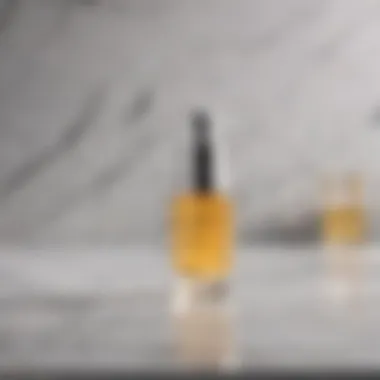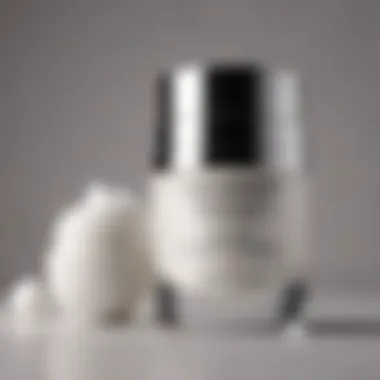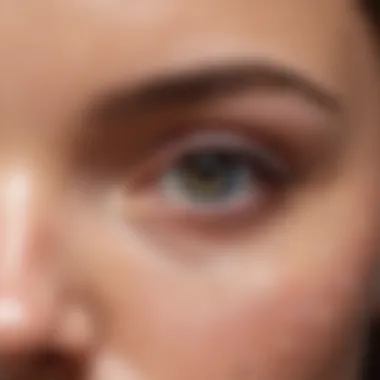The Role of Retinol in Skincare and Its Application


Intro
The world of skincare is packed with a cacophony of products, ingredients, and techniques, each claiming to be the miracle solution to your skin woes. Among these, retinol has carved out a remarkably notable reputation. Whether your skin is prone to breakouts, looking for anti-aging solutions, or figuring out how to maintain that elusive glow, retinol often emerges as a go-to option. Yet, most folks find themselves scratching their heads about how best to incorporate it into their routine—specifically about whether it should go on before or after moisturizer.
The Significance of Retinol
Retinol, essentially a derivative of vitamin A, works wonders by promoting cell turnover and enhancing skin texture. It’s like giving your skin a gentle nudge to shed those old, dead cells hiding the fresh, youthful ones beneath. With that said, this powerful ingredient is notorious for being somewhat temperamental. Therefore, how, when, and where we apply it can significantly influence its effectiveness—all crucial points for anyone eager to step up their skincare game.
The Dance Between Retinol and Moisturizers
The interplay between retinol and moisturizers is where things get intriguing. Applying retinol and following it immediately with a moisturizer is a common practice, but how does it truly affect the efficacy of the treatments? The confusion often lies in understanding whether retinol loses its power when layered under other products or if it can be maximized in conjunction with those hydrating elements.
In this exploration, we aim to break down the complexities surrounding retinol. We'll dive headfirst into its myriad functions, examine the necessary role moisturizing plays, and provide insights into optimal application techniques. Overall, we're not just looking to scratch the surface; we’re keen on delving deep, examining diverse skin types, and ultimately guiding you towards informed choices that can breathe life into your skincare regimen.
Understanding Retinol
Understanding retinol is crucial for anyone venturing into skincare, especially for those keen on bettering their skin health. This vitamin A derivative has been a significant player in the skincare game for decades, celebrated for its transformative properties. It's essential to grasp what retinol is, why it's beneficial, and how its various forms impact the skin, which provides a solid foundation for anyone looking to incorporate this ingredient into their routine.
What is Retinol?
Retinol is a form of vitamin A that helps stimulate cell turnover and promote the growth of new skin cells. It's lighter than its fellow retinoids, which can come from both natural and synthetic sources. When we talk about retinol in skincare, we often refer to a stable form that can penetrate the skin effectively. It's a bit like inviting a reliable friend to a party – they bring the best vibes and help everything flow smoother.
Beyond just a simple chemical, retinol plays a substantial role in preventing signs of aging. By encouraging collagen production, it aids in reducing fine lines and wrinkles, making it a go-to solution for those looking to maintain youthful skin. Think of it as flipping the calendar back a few years; it can target the dullness and rough texture that creeps in over time.
Benefits of Retinol for the Skin
The advantages of incorporating retinol into your skincare routine are numerous. Notably, these include:
- Accelerated Cell Turnover: Retinol encourages quicker shedding of dead skin cells while promoting the growth of fresh ones, akin to giving your skin a little spring cleaning.
- Firmness and Elasticity: By boosting collagen, retinol can help maintain the skin's firmness and elasticity, helping your complexion look toned and vibrant.
- Minimized Pores: Regular use can lead to the reduction of pore size, given that it helps unclog pores and combat the effects of acne.
- Even Skin Tone: Over time, retinol contributes to a more uniform skin tone, addressing pigmentation issues and age spots. It's like gradually discovering lighter shades in a classic painting.
Not all skins respond the same way to retinol, so it’s important to proceed with care, especially for those with sensitive skin or other underlying issues.
Types of Retinoids
Not all retinoids are created equal, and knowing the different types can help tailor your routine to fit your skin's unique needs. Here’s a quick rundown:
- Retinol: The most widely used type in over-the-counter products, it is effective for most skin types without harsh effects.
- Retinaldehyde: A step up from retinol in potency. It is often found in more specialized skincare products.
- Tretinoin (Retin A): This is a prescription-only version known for its strength; it’s typically used to address more severe skin concerns such as acne or deep wrinkles.
- Adapalene: Another prescription retinoid, popular for treating acne. It's gentler, making it suitable for sensitive skin types.
Knowing the type of retinol that best suits your skin can make all the difference. Each one works differently, and what suits one person might not be ideal for another, so it's wise to consult a dermatologist before diving deep into the retinol rabbit hole.
The Purpose of Moisturizers
Moisturizers hold a pivotal place in any skincare regimen, particularly in the realm of retinol application. While retinol works diligently to promote cellular turnover, moisturizers act as a safeguard, offering hydration and protection to the skin. The interplay between these two components is key to not only maintaining skin's texture but also ensuring optimal results when integrating retinol into one’s routine.
Functionality of Moisturizers
Moisturizers serve multiple critical functions in skincare. At their core, they provide water to the skin and help prevent trans-epidermal water loss. A good moisturizer can create a barrier that locks hydration in, keeping the skin supple and plump. Moreover, these products often contain emollients that soften the skin, providing a smooth surface. Here are some key functionalities:
- Hydration: Helps restore moisture balance, which can be particularly essential when using drying agents like retinol.
- Barrier Protection: Shields the skin from environmental aggressors such as pollution and weather, which can exacerbate dryness.
- Skin Comfort: Alleviates irritation that may arise from active ingredients like retinol.
It's clear that without an effective moisturizer, the skin may not only miss out on nourishment but can also suffer from increased sensitivity, especially when potent products like retinol are part of the routine.


Hydration vs. Moisturization
It’s easy to confuse hydration and moisturization, yet they are distinct processes. Hydration refers to the water content in the skin, while moisturization involves the addition of oils that help lock that water in. This distinction is especially important when selecting products. Products labeled as hydrating often contain ingredients like hyaluronic acid, which attract moisture to the skin. On the other hand, moisturizing products might include natural oils, ceramides, or shea butter, focusing on sealing in hydration.
To strike a balance, consider the following:
- Hydrate First: Use a hydrating serum or toning mist before applying moisturizer.
- Moisturize Daily: Incorporate a moisturizer that complements your skin type to maintain a healthy moisture barrier.
Different Types of Moisturizers
When it comes to moisturizers, one size definitely does not fit all. There are different formulations designed to meet specific skin needs and types. Here are some common types:
- Creams: Hefty and rich, ideal for dry skin requiring more intensive nourishment.
- Lotions: Lighter in texture, suitable for normal to slightly dry skin types that don't need heavy moisture.
- Gels: Water-based and absorb quickly, perfect for oily or acne-prone skin while still providing hydration.
- Ointments: Thick and occlusive, excellent for treating severely dry patches.
Understanding the difference can guide consumers in choosing the right product that complements their use of retinol. Just remember, layering the right moisturizer can make all the difference, promoting a balanced, radiant complexion.
"Choosing the right moisturizer is not only about skin type but also about understanding what your skin needs at different times."
The efficacy of retinol is undeniably enhanced with the right moisturizer, making it an indispensable partner in the quest for flawless skin.
Optimal Application Techniques
The world of skincare often feels like navigating through a maze, particularly when it comes to applying products like retinol. Understanding optimal application techniques is crucial for maximizing the benefits retinol offers and minimizing any potential downsides. Proper application can make a world of difference, ensuring that your skincare routine is not just a series of steps, but a well-orchestrated process leading to healthier skin. The discussion surrounding retinol usage is not just about the product itself but also about how and when to use it effectively.
When to Use Retinol
Timing is everything, especially in skincare. Using retinol too early or too late in your routine may hinder its effectiveness. Typically, retinol is most beneficial during the evening. Why? Simply put, your skin goes into repair mode while you sleep, and retinol enhances this process. This means that applying retinol at night allows it to work while your skin is focused on regeneration. However, if you prefer morning routines, layered with sunscreen, you can still use it, as long as precautions against sun sensitivity are taken.
Before vs. After Moisturizer
An age-old debate in the skincare community is whether to apply retinol before or after moisturizer. Generally, applying retinol before moisturizer is recommended. This ensures that the active ingredients in the retinol penetrate the skin without interference. Think of it this way: direct contact with the skin maximizes its absorption. However, if you have particularly sensitive skin, applying a soothing layer of moisturizer beforehand can help ease irritation. It’s all about finding that sweet spot of balance for your skin type.
Layering Products Correctly
Mastering the art of layering products can elevate your skincare game by leaps and bounds. It’s not just about slapping products on your face—there’s a method to the madness. Start with a clean face, as this removes any impurities that can obstruct product effectiveness. After cleansing, you might want to incorporate a serum that caters to your skin's specific needs, followed by the application of retinol. After that, seal everything in with a moisturizer.
A Practical Guide to Layering:
- Cleanser: Choose one suitable for your skin type.
- Toner or Serum (optional): Use products that complement retinol.
- Retinol: Apply a pea-sized amount evenly across your face.
- Moisturizer: Finish off with a nourishing moisturizer to lock in hydration.
Remember, the key to effective layering lies in understanding the ingredients of each product. The right combination can enhance effectiveness and tackle multiple skin concerns at once.
"The secret to glowing skin lies not just in the products, but in how you apply them."
In summary, mastering the application techniques for retinol can pave the way for a successful skincare routine. Being aware of when to apply it, whether to layer it under or over a moisturizer, and how to properly layer products is fundamental in achieving your skincare goals.
Exploring Skin Types
Understanding is crucial when incorporating retinol into any skincare routine. Different skin types require tailored approaches, as what works wonders for one may cause irritation for another. The interplay between the unique characteristics of each skin type and retinol’s properties dictates how effective the treatment can be. So, diving into specific skin considerations becomes essential for achieving optimal results and ensuring the skin remains healthy and radiant.
Sensitive Skin Considerations


For those with sensitive skin, using retinol demands a degree of caution. Sensitive skin is often characterized by factors like redness, irritation, and a proclivity for allergic reactions. Applying retinol can sometimes exacerbate these existing conditions. To minimize potential drawbacks:
- Start Slow: Consider beginning with a low concentration. This gradual introduction can help the skin acclimate over time.
- Patch Test: Always conduct a patch test before applying it on the whole face. This step helps to gauge skin reactions without causing widespread irritation.
- Seek Balance: Pairing retinol with soothing ingredients such as hyaluronic acid or aloe vera can help counteract dryness and irritation.
By being mindful of these factors, those with sensitive skin can harness the benefits of retinol without undue discomfort.
Oily vs. Dry Skin
Both oily and dry skin types can greatly benefit from retinol, but the approaches differ markedly based on their unique needs.
For Oily Skin:
- Extra Exfoliation: Oily skin tends to trap excess sebum and dead cells, which can lead to clogged pores. Retinol helps by promoting cell turnover and reducing these blockages.
- Lower Moisturization Needs: While hydration is still necessary, those with oily skin might not need heavy moisturizers. A light, non-comedogenic product can suffice here, enhancing the effectiveness of retinol.
For Dry Skin:
- Focus on Hydration: Dry skin can struggle with moisture retention, making it paramount to prioritize hydration before applying retinol. Using thick cream formulations might be necessary, ensuring that the skin barrier remains intact.
- Layering Products: A good routine might include hydrating serums and oils applied after retinol. This layering can prevent excessive dryness and irritation, keeping the skin supple.
Ultimately, understanding your skin type allows you to customize how you introduce and utilize retinol, optimizing its benefits while maintaining skin balance.
Aging Skin and Retinol
Aging skin often reflects a depletion of natural collagen and elasticity, leading to visible wrinkles and fine lines. Retinol plays a transformative role in this regard due to its ability to accelerate cell turnover and enhance collagen production.
- Wrinkle Reduction: Regular use of retinol can soften fine lines and deep wrinkles, making skin appear more youthful. Some studies suggest that consistent application can even improve skin texture and tone.
- Boosting Radiance: Aging skin also tends to look dull. Retinol can promote a brighter complexion by sloughing off dead skin and encouraging the growth of new skin cells.
- Considerations for Sensitive Aging Skin: Many individuals have aging skin with a sensitive nature. For them, starting with a lower strength retinol is advisable, gradually increasing the dosage as tolerance builds. This adjustment helps mitigate risks of redness and irritation while receiving retinol’s benefits.
Conclusively, retinol emerges as a vital ally in the quest for youthful skin. Regardless of skin type, understanding the nuances of application tailored to individual needs can lead to empowered, informed skincare choices.
Addressing Common Concerns
In the skincare realm, when conversations turn to retinol, it's not all sunshine and rainbows. This powerful ingredient often brings with it a flurry of questions and concerns, particularly among those new to incorporating it into their regimen. Addressing common issues surrounding retinol is crucial, as it ensures users can harness its full potential while minimizing discomfort and achieving desired results. The focus here will be on understanding side effects, managing irritation, and navigating sun sensitivity, all of which are vital for informed skincare decisions.
Potential Side Effects of Retinol
With great power comes great responsibility—but also potentially unwelcome side effects. Retinol, while a darling in the skincare community, can occasionally cause a skin reaction. Some common side effects include:
- Dryness: It's not unusual for skin to feel like the Sahara after starting retinol, especially if you're not used to such a potent product.
- Redness and Peeling: Many users experience a flaking that might feel more like a bad sunburn than a rejuvenating glow.
- Breakouts: Although some people expect miracles, retinol can sometimes agitate skin initially, leading to breakouts as the skin adjusts.
It's important to note that these effects are generally short-lived, usually fading as the skin acclimates. Consider introducing retinol gradually—perhaps two to three times a week—then work your way up as your skin becomes less reactive.
Managing Skin Irritation
Managing skin irritation when using retinol can feel like walking a tightrope, but it’s certainly achievable with a few thoughtful strategies. Keeping your skin barrier intact is key to minimizing sensitivity. Here are a few crucial tips to make the process smoother:
- Start Slow: Allow your skin to adapt by using a low concentration of retinol first.
- Hydrate: Incorporating a quality moisturizer can help counteract dryness and give your skin much-needed moisture post-application.
- Buffering: Applying moisturizer before retinol can lessen irritation, as it creates a barrier to soothe your skin.
Additionally, listen to your skin. If irritation persists even after adjusting your routine, it may be wise to pause or consult a dermatologist for personalized guidance.
Retinol and Sun Sensitivity
One common concern that springs up regarding retinol is its notorious relationship with sun exposure. While retinol strives to enhance your skin’s texture and tone, it can also increase your skin’s vulnerability to the sun. It’s imperative to keep in mind:


"Using retinol without sun protection is like embarking on a journey without a map."
Here are steps to tackle sun sensitivity:
- Daily SPF: Incorporating a broad-spectrum sunscreen with at least SPF 30 during the day is non-negotiable. This shields the skin from harmful UV rays and helps prevent further irritation.
- Timing: Using retinol primarily as a nighttime product can effectively minimize sun exposure, allowing for recovery while you sleep.
- Protective Clothing: Consider wearing hats and long sleeves if you plan to be outside, enhancing your defense against the sun.
In summary, while retinol is a potent skincare ally, addressing potential concerns head-on is paramount. By acknowledging side effects, managing irritation thoughtfully, and practicing diligent sun protection, users can reap the rewards of this transformative ingredient while maintaining skin health.
Expert Opinions
When it comes to skincare, expert opinions serve as a crucial compass guiding both novices and skincare aficionados alike. Particularly in the realm of retinol, the insights from dermatologists and skincare specialists can help navigate the myriad of products and application techniques available. This section articulates the value of these professional recommendations, emphasizing their benefits for creating a personalized skincare routine that maximizes the efficacy of retinol while minimizing potential side effects.
Dermatologists Weigh In
Dermatologists, being the gatekeepers of skin health, play a pivotal role in elucidating the complexities surrounding retinol. These specialists are trained not just to diagnose skin conditions but also to recommend tailored skincare regimens. According to leading dermatologists, one of the key factors in successful retinol application is understanding your specific skin type and concerns.
- Individualized Guidance: A skin assessment helps determine if retinol is appropriate, the concentration to use, and the frequency of application. People with sensitive skin may need to start with lower concentrations, while those with oily skin might tolerate stronger formulations.
- Clarifying Myths: Dermatologists often tackle common misconceptions about retinol use, such as the belief that it’s only for older skin. They assert that early incorporation can be beneficial for preventative care, helping to delay the signs of aging.
- Addressing Safety: Experts provide a wealth of knowledge on managing potential side effects, such as irritation and peeling, emphasizing the importance of gradual introduction into one’s regimen. As one dermatologist puts it, "Starting slow but steady is the golden rule with retinol."
"The journey with retinol is as unique as your skin; it’s not a one-size-fits-all solution."
— Dr. Jane Smith, Dermatology Expert
Skincare Specialists’ Recommendations
Skincare specialists, such as estheticians, bring a hands-on perspective to the everyday application of retinol. Their recommendations often complement the medical insight provided by dermatologists, focusing on practical ways to integrate retinol into daily routines while maintaining skin health.
- Layering Wisdom: Specialists often emphasize the importance of layering products correctly — suggesting that retinol should typically be applied on clean, dry skin to enhance absorption, particularly before heavier creams or oils.
- Product Selection: As specialists work closely with various brands, they can recommend specific formulations that suit individual skin types, helping consumers sift through the often overwhelming choices. They may lean towards milder products for beginners, gradually introducing stronger options.
- Consistent Use: Another vital piece of advice from skincare specialists is commitment. They stress that consistency is key in achieving the desired results with retinol. Skipping applications can hinder progress, turning an excellent investment into wasted effort.
- Follow-Up Care: Additionally, specialists often advocate for incorporating soothing ingredients, like hyaluronic acid or niacinamide, in conjunction with retinol to manage dryness and irritation. They remind clients that a well-rounded regimen is more effective than one focused solely on retinol.
In summary, the insights from dermatologists and skincare specialists resonate through every layer of retinol application. Their combined knowledge not only demystifies the usage of retinol but ultimately helps in crafting a skincare journey that is both effective and sustainable.
Final Thoughts and Recommendations
Recognizing the critical aspects of incorporating retinol into a skincare routine leads to better practices and outcomes. Retinol's filtering effects on skin health are not merely about using a product; it's about integrating it sensibly and knowing its unique characteristics alongside other elements of skincare. This section wraps up practical advice, highlighting how individuals can best optimize their routines to reap maximum benefits.
Tailoring Your Routine
Customizing your skincare regimen around retinol hinges on understanding your skin type and its particular needs. Each skin type reacts differently to retinol, meaning a methodical approach is key. For instance, those with dry or sensitive skin might consider starting with a lower concentration of retinol, gradually phasing into more vigorous doses.
Consider blending retinol with a hydrating serum if dryness becomes an issue. A simple routine might include:
- Evening: Cleanser → Retinol → Hydrating serum → Moisturizer
- Morning: Cleanser → Moisturizer with SPF
Laying out a consistent schedule will allow your skin to adjust over time, minimizing any potential irritation. Regularly check in with your skin’s response and make adjustments if needed. Always remember, patience is critical when using retinol.
Common Mistakes to Avoid
Even the most seasoned skincare enthusiasts can slip up with retinol. Here are a few common traps:
- Over-application: Just because more often seems better doesn’t mean you should slather it on daily without giving your skin a breather.
- Neglecting sunscreen: Retinol typically increases sun sensitivity, so skipping SPF is not just a mistake; it’s counterproductive.
- Mixing with harsh products: Jumping headfirst into blending retinol with acids or scrubs can wreak havoc on your skin.
Being mindful of these slip-ups not only helps your skin but also makes sure you don’t waste products.
Resources for Further Reading
To deepen your understanding and navigate the world of retinol, consider diving into the following resources for more intricate details and expert opinions:
- Wikipedia on Retinoids
- Britannica's Guide to Skincare
- Engage in discussions at Reddit - Skincare Addiction for personal experiences and recommendations.
Understanding retinol isn’t merely about applying a product; it’s about embracing a holistic approach to skincare that factors in skin type, application, and potential errors. While the journey may be paved with trials, each experience brings you closer to achieving the optimal, radiant skin you desire.



